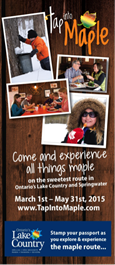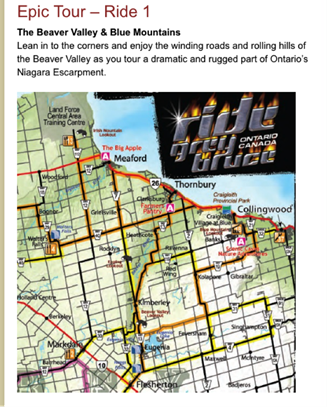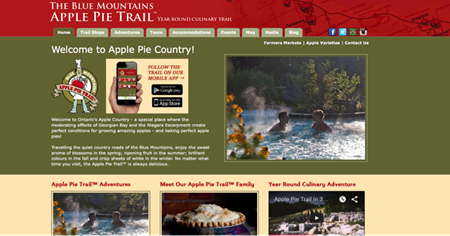Kim Clarke, Tourism Experience Development Specialist for RTO7, explains the benefits self-guided tours can bring to your tourism business.

Touring, whether on a bike, in a boat or in a car, has always been a staple of product development for Destinations Marketing Organizations (DMOs). For DMOs, the self-guided route often presents the best opportunities to encourage visitors to extend their stays. Self-guided tours can provide opportunities to showcase the little known places or clusters of similar places that, on their own, might not be worth coming to see. Our region is well positioned to leverage the benefits of this type of product development. Some of the most successful products in our area are self-guided tours including the Apple Pie Trail, the Explore the Bruce Adventure Passport and the Tap into Maple route. These three trails all have something in common - they unite a series of places using one key theme, whether it’s maple syrup, apples or adventure.
The development process is simple, but that doesn’t mean that it’s easy! First, think of a theme. This should tie together a group of places, businesses or attractions. I like to call this the art of critical mass. These places on their own might not warrant a trip but together, with a group of similar products, they become worthy of a visit. An effective example of this is the Huron Kinloss Ice Cream Trail.
The second approach is to think of the tour as the core trip motivator (the main reason for travel) with the theme focused on how people are going to travel. For example, people might travel on a bicycle, in a car or on a motorcycle. What are they going to see and do using this method of transportation? Developing a set of criteria for the attractions, accommodation and restaurants will help you decide what should be included on the tour. Events themed around the mode of transportation (like a car show) will create urgency for visitors to come and add credibility to the tour.

Next, bring in supporting businesses. These include accommodation, restaurants, and services that pertain to the trip. For snowmobiles, that might include gas stations and repair shops. Again, using criteria to qualify business is a great approach. This provides objectivity, especially for DMOs. If there are two components to the marketing plan - online and a printed piece - then a sliding scale offers businesses who are interested in participating more opportunities to partake in the program while maintaining a high quality product to meet, and hopefully exceed, consumer expectations. For example, if there are twelve criteria and a business can meet more than eight of the twelve, they can then be listed in the brochure and on the website. Businesses that meet between five and seven of the criteria could just be listed on the website. This also provides incentive for the businesses to try and meet more of the criteria for future campaigns.

Some DMOs add an additional fee for businesses to be listed in the brochures. This helps things in two ways; first it helps to fund the production cost of the brochure, and secondly, it keeps the businesses engaged as they have some skin in the game. The key is to ensure you are providing great value to the businesses.
The final step is to take all the points of interest, participating businesses and identified routes (trails or roads) to link them together. Good mapping is vital. Although technology has taken us a long way, there is still a place for a good, old-fashioned printed map.
Now comes the tough part. How do you measure it to see if it’s working? There are a few different ways to measure success and perhaps a combination of all of these things is the best method. Having a dedicated microsite or landing page on your and your partner’s websites will allow measurement of visits, length of stay on the website, downloads, etc. If you print a map, then the number of maps that are distributed is another measure. These numbers are useful to determine interest, but finding out how interest translates into sales becomes the tricky part. The number of visitors (40km
[1] +) at events around the same theme is important. Training tour and DMO partners to ask visitors if they are coming because of a particular tour is another tactic. Remembering to ask and have everyone record the information in the same manner can be difficult.
The most important thing to take away from this is to note that this type of product development is highly reliant on cooperation among a variety of stakeholders. “It’s the rising tide raises all ships” approach. The more activity visitors have to do, the longer they will stay, the more often they will come back and hopefully, the more money they will leave behind.
RTO7 is committed to helping stakeholders create new products and experiences for visitors to increase length of stay, tourism receipts and repeat trips. For more information on product and experience development, contact Kim Clarke, Tourism Experience Development Specialist at
kclarke@rto7.ca or 519-379-2506.